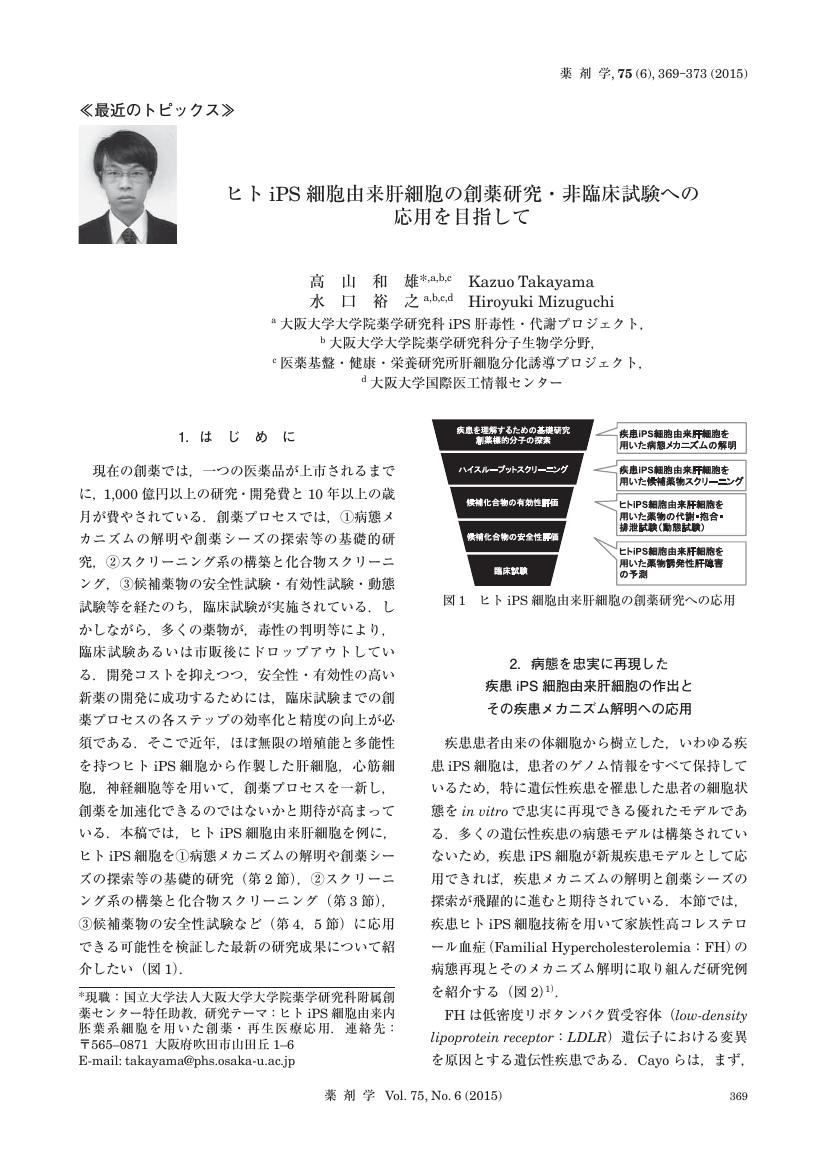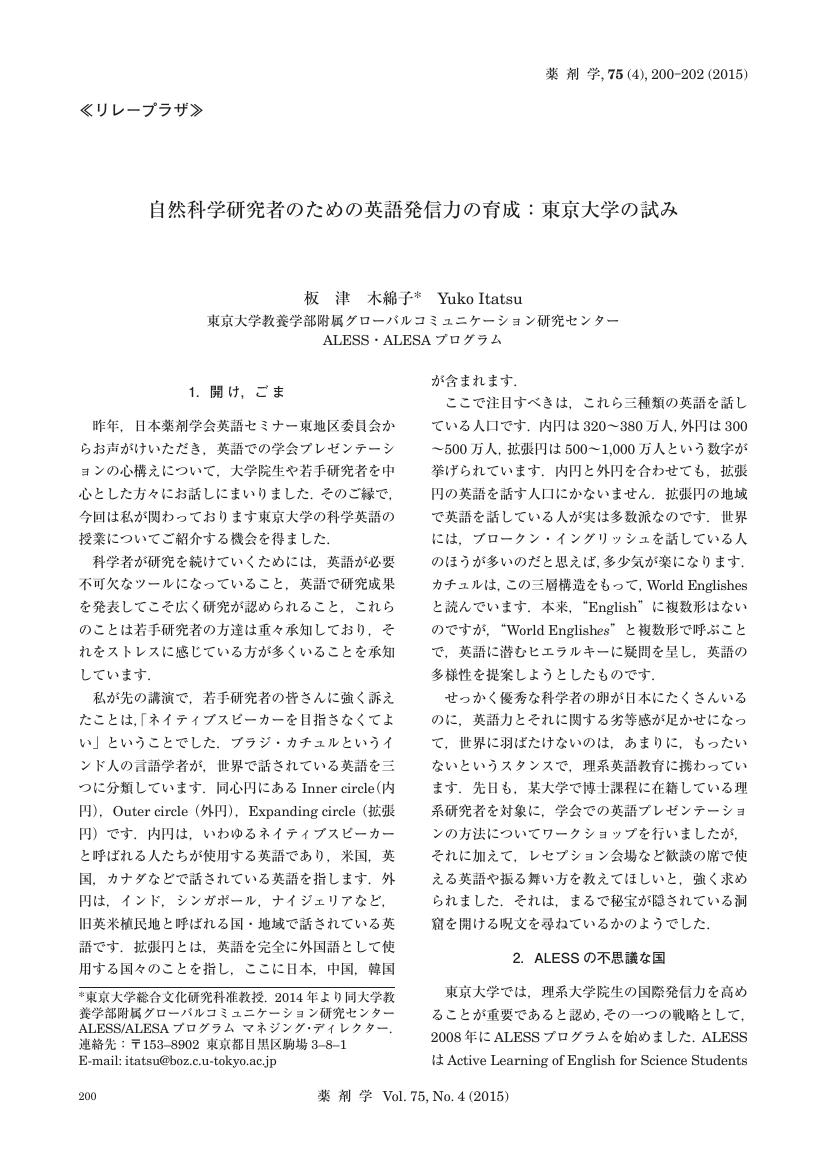1 0 0 0 OA 医療用緑内障点眼剤の開発変遷の分析
- 著者
- 中田 雄一郎
- 出版者
- 公益社団法人 日本薬剤学会
- 雑誌
- 薬剤学 (ISSN:03727629)
- 巻号頁・発行日
- vol.75, no.1, pp.65-71, 2015 (Released:2015-01-01)
- 参考文献数
- 10
From descriptions on the package inserts and interview forms accessible on the home page of the Pharmaceuticals and Medical Devices Agency (PMDA), the characteristics of active pharmaceutical ingredients, pharmaceutical production, and formulations of 106 glaucoma therapeutic agents currently used in clinical practice in Japan were analyzed. Since eye drops are a sterile preparation and are administered multiple times, their efficacy, safety, stability and preservation must be taken into consideration. The pH (4-8) and osmotic pressure (0.6-1.6) were well controlled within a fixed range and some additives were compounded in the eye drops for the purpose of making the users feel more comfortable. It was also found that there was a difference in the use of solubilizing agents and preservatives between domestic and global pharmaceutical companies. There has been no article to compare the eye drop formulations of glaucoma therapeutic agents for 45 years; therefore, this paper will help to show future directionality of the preparation development of eye drops.
- 著者
- 山西 芳裕
- 出版者
- 公益社団法人 日本薬剤学会
- 雑誌
- 薬剤学 (ISSN:03727629)
- 巻号頁・発行日
- vol.78, no.2, pp.77-81, 2018 (Released:2018-03-01)
- 参考文献数
- 5
1 0 0 0 OA miRNAによる薬の代謝・毒性制御
- 著者
- 中島 美紀
- 出版者
- 公益社団法人 日本薬剤学会
- 雑誌
- 薬剤学 (ISSN:03727629)
- 巻号頁・発行日
- vol.76, no.2, pp.99-104, 2016 (Released:2016-09-01)
- 参考文献数
- 5
1 0 0 0 OA ヒトiPS細胞由来肝細胞の創薬研究・非臨床試験への応用を目指して
- 著者
- 高山 和雄 水口 裕之
- 出版者
- 公益社団法人 日本薬剤学会
- 雑誌
- 薬剤学 (ISSN:03727629)
- 巻号頁・発行日
- vol.75, no.6, pp.369-373, 2015 (Released:2016-05-01)
- 参考文献数
- 5
1 0 0 0 OA 自然科学研究者のための英語発信力の育成:東京大学の試み
- 著者
- 板津 木綿子
- 出版者
- 公益社団法人 日本薬剤学会
- 雑誌
- 薬剤学 (ISSN:03727629)
- 巻号頁・発行日
- vol.75, no.4, pp.200-202, 2015 (Released:2016-01-01)
1 0 0 0 OA がん切除手術に用いられるMohsペーストに関する製剤学的研究
- 著者
- 山本 浩充 小林 万里 芳賀 吏那子 伊東 奈保美 小川 法子 田口 真穂 高橋 千里 礒部 隆史 埴岡 伸光 村田 実希郎 岡田 賢二 重山 昌人
- 出版者
- 公益社団法人 日本薬剤学会
- 雑誌
- 薬剤学 (ISSN:03727629)
- 巻号頁・発行日
- vol.75, no.4, pp.264-270, 2015 (Released:2015-07-01)
- 参考文献数
- 9
- 被引用文献数
- 5
Mohs paste is using for chemosurgery to treat local recurrence of breast cancer tumors and other tumors. However, physicochemical properties of Mohs paste such as hardness, viscosity, stickiness, and spreadability, change signifi cantly during storage after preparation. We investigated the mechanism of change in these physicochemical properties and reformulated Mohs paste. Mohs paste was very hard immediately after preparation and then gradually became soft and sticky during storage. We found that starch particles in the formulation caused the change in physicochemical properties. The initial hardening of the paste was caused by water adsorption and swelling of starch granules. The ensuing softening and tackifying were caused by gelatinization of the starch. The change in physicochemical properties could be restricted by reduction of free water in the formulation by adding a sugar alcohol. Sorbitol was the most effective material among additives because sorbitol can interact strongly with hydration water.
1 0 0 0 OA 創薬・医療への応用を指向した薬物動態研究
- 著者
- 楠原 洋之
- 出版者
- 公益社団法人 日本薬剤学会
- 雑誌
- 薬剤学 (ISSN:03727629)
- 巻号頁・発行日
- vol.75, no.2, pp.99-104, 2015 (Released:2015-09-01)
- 参考文献数
- 5
1 0 0 0 OA 日本薬剤学会公開市民講演会を聴講して
- 著者
- 井上 裕
- 出版者
- 公益社団法人 日本薬剤学会
- 雑誌
- 薬剤学 (ISSN:03727629)
- 巻号頁・発行日
- vol.74, no.2, pp.150-151, 2014 (Released:2014-09-01)




